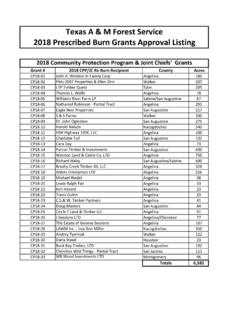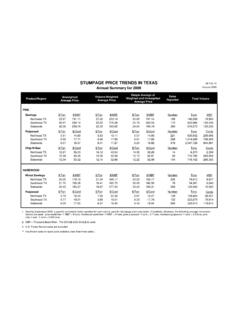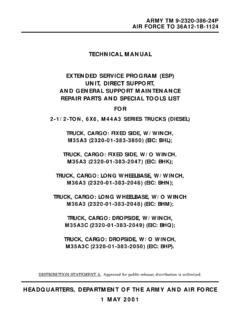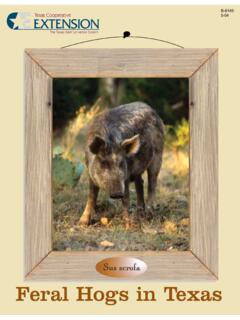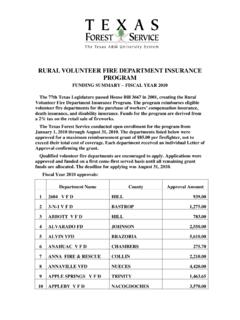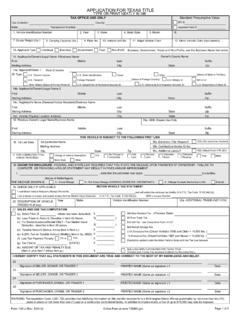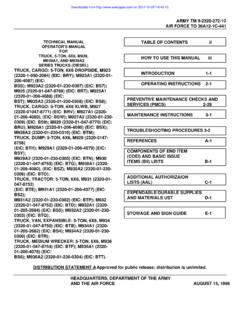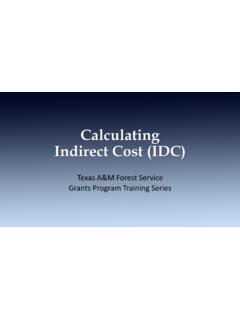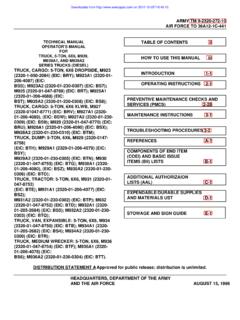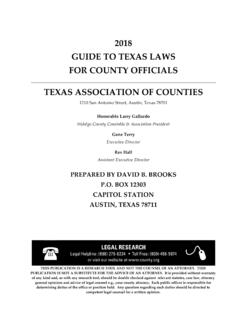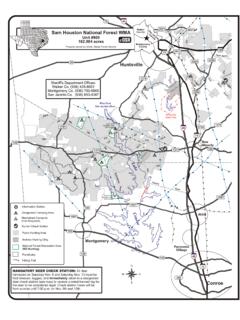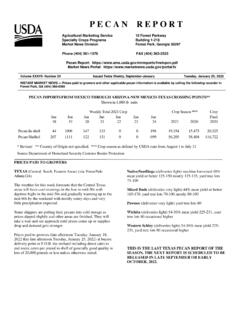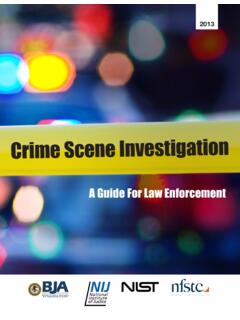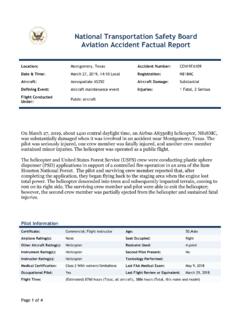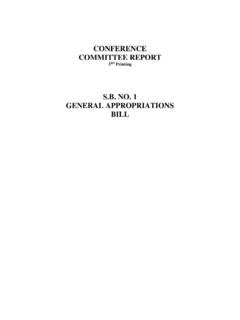Transcription of Dichotomous Key Activity - Texas A&M Forest Service Home …
1 Dichotomous Key Activity Students practice using a Dichotomous tree key and then create their own place-based tree key. Materials Activity Key Getting Started on Leaf Characteristics Sample Leaf Cards Tree Information Cards Resources Texas A&M Forest Service , Trees of Texas o How to ID: o ID by Leaf: o List of Trees: o Leaf Collection & Safety: Arbor Day Foundation o What Tree Is That?: Instructions 1. Print Activity pages, cutting Sample Leaf and Tree Information Cards apart. Print either a set for each group or individual, or enough to swap during the Activity . 2. Review the handout Getting Started with Leaf Characteristics or use the How to ID section of the Trees of Texas website with students.
2 3. Provide the students with one of the Sample Leaf cards. Ask students to observe the characteristics of leaves: leaf tips and bases, leaf margins, leaf textures, leaf structure, and leaf arrangements. Optional: have them write a list of the characteristics for their leaf. 4. Have students use the Activity Key to identify their tree species. 5. Once the students have identified their species, give them their declared Tree Information Card to verify their decision. They can also look up their tree on the List of Trees section of the Trees of Texas website to review more information. 6. Have students continue practicing with the key by identifying all of the Sample Cards.
3 7. If leaves are available on your local trees, have students collect samples. Review the Leaf Collection & Safety section of the Trees of Texas website with students. 8. Have students identify their collected species using the ID by Leaf key on the Trees of Texas website or the What Tree Is That? key from the Arbor Day Foundation website. Extension Create a place-based tree key that is unique to your campus. Have your students choose trees to include, collect leaf samples, categorize the leaves based on their characteristics, then write out a key. After creating the key, have another class or another group use it to identify the local trees.
4 Publish a print copy of the key to share or add a digital version to your school website. If your class or school already has a Tree Trail, consider creating a key for the trail. If you do not have a Tree Trail, find more information about creating one at Question 1 Is the tree coniferous? Does the tree have needle-like leaves and bear cones?.. OR Is the tree a broadleaf? Does it have thin, flat leaves?.. Yes, you have a Loblolly Pine. Yes, go to Question 2. Question 2 Are the leaves simple? Is there one leaf attached to the petiole?.. OR Are the leaves compound? Are there multiple leaflets on a single petiole?
5 Yes, go to Question 3. Yes, go to Question 4. Question 3 Are the simple leaves opposite?.. OR Are the simple leaves alternate?.. Yes, you have a Red Maple. Yes, go to Question 5. Question 4 Are the compound leaves alternate with lanceolate shaped leaflets?.. OR Are the compound leaves opposite with oval shaped leaflets?.. Yes, you have a Pecan. Yes, you have a Texas Ash. Question 5 Are the margins serrated or toothed and is the leaf shape oval?.. OR Are the margins lobed and is the leaf apex rounded?.. Yes, you have an American Elm. Yes, you have a Post Oak. Sample Leaf Cards Key T REE TR AILSG etting Started on Leaf CharacteristicsParts of a LeafStemBaseMargin or EdgePetioleTip or ApexPrimary Vein or MidribSecondary or Lateral VeinsBladeLeaf MarginsLobed Rounded segment not divided all the way to the midribEntire Having a smooth edgeSerrated/ToothedHaving sharp, saw-like teethDentate Having triangular, tooth-like teethIllustrations copyright by Robert O BrienTo find more Leaf Characteristics, visit the Trees of Texas website s How to ID section.
6 Having more than one leaflet per leaf Simple Having one blade per leafFinding the bud will help determine simple or compound arrangementLeafletsSimple & Compound LeafLeaf ArrangementOpposite Leaves are attached opposite each other on the stemAlternate Leaves are attached alternately along the stemWhorled 3 or more leaves are attached at the same point on the stemLeaf Apexes and BasesRoundedBristle Acuminate Long tapered pointCuneate Wedge-shapedRoundedInequalateral Not same on both sidesTruncate Squared offAcuteLeaf ShapesDeltoidOvalLanceolateStarTree TypeConiferous - a tree with needles or scales instead of leaves, bearing conesBroadleaf - a tree with wide flat leavesPost OakLeafDeciduous leaves are 4 to 6 inches longLobes form a cross shapeTree DescriptionMedium to large sizeUp to 50 feet tall with trunk 2 feet in diameterBarkThick, gray-brownNarrow, irregular cracks and scaly ridges on older treesWoodHeavy, hardUsed for crossties and fence posts, sometimes for lumberNotesSo common that an entire ecoregion is named Post Oak SavannahTrees of Texas website ElmLeafDeciduous leaves are 4 to 6 inches long, 2 to 3 inches wideOval.
7 Tip comes to a pointBase is lopsided and double toothedTree DescriptionLarge size, up to 90 feet tallBarkDark grayDivided into irregular flat-topped, thick ridgesWoodHeavy, hard, strongOnce used for wheel hubs, furniture parts, veneer for basketsNotesHistorically a common street tree, but almost wiped out by Dutch Elm DiseaseTrees of Texas website MapleLeafDeciduous leaves are 2 to 5 inches longHas 3 to 5 pointed saw-toothed lobesIn autumn, leaves turn a brilliant shade of red or orange-yellowTree DescriptionMedium size, fast growing, reaches 90 feet tallBarkSmooth and light gray on young treeRough, scaly, dark gray on old limbs and treesWoodHeavy, close-grained, light brown colorUsed for furniture, turned items, fuelNotesAlso named Swamp Maple, Trident Maple, Drummond Red MapleTrees of Texas website leaves have 11 to 17 leaflets, lanceolateMargins are finely-toothed and long-pointedTree DescriptionLarge size, but can grow tall and slender in wooded settingsUp to 120 feet tall with trunk 4 feet in diameterBarkGray-brown and smooth at firstThin scales on older trees that flake off.
8 Creating a rough textureWoodHeavy and hard, but brittle and not strongUsed for flooring and cooking wood, especially for barbequesNotesState tree of TexasTrees of Texas website PineLeafEvergreen needles in bundles of three, 5 to 10 inches longTree DescriptionLarge, fast growingUp to 125 feet tall with trunk 4 feet in diameterBarkThick, dark red-brown to black flaky platesWoodMost commercially valuable southern pine, coarse-grained For lumber, posts, boxes, pulp, and many more usesNotesSouthern Pine Beetle once damaged large pine stands that today are protected by sustainable management practices Find more at of Texas website AshLeafDeciduous leaves with 5 oval or round leafletsDark green on top, lighter belowTree DescriptionMedium sized.
9 Oval crownUp to 45 feet tall with trunk 2 feet in diameterBarkGray with brown or black blotches with interlocking flattened ridgesWoodLight colored with brown heartwoodUsed for firewood and flooringNotesEmerald Ash Borer is a threat to all ash species and has been recently discovered in Texas Find more at of Texas website
